
Placida dendritica?
'Southeastern Australia'
Order: SACOGLOSSA
Superfamily: LIMAPONTIOIDEA
Family: Limapontiidae
DISTRIBUTION
Southeastern Queensland, New South Wales, Victoria.
PHOTO
UPPER RIGHT: West Head, Flinders, Western Port, Victoria, March 1986.
LOWER: on Codium sp.. Two Fold Bay, New South Wales, March 1986. PHOTOS: Bill Rudman.
See Cynthia Trowbridge's message suggesting there are many regional species around the world being erroneously identified as Placida dendritica. See photo of a specimen from Taiwan.
See Polynesian form Page.
See Atlantic form Page.
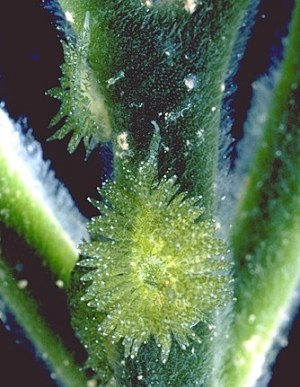
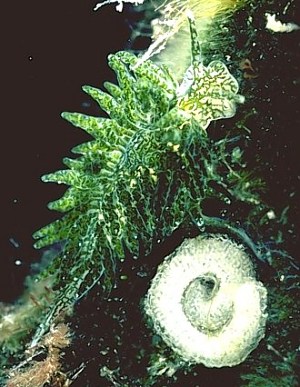
Rudman, W.B., 1999 (August 14) Placida dendritica? 'Southeastern Australia'. [In] Sea Slug Forum. Australian Museum, Sydney. Available from http://www.seaslugforum.net/find/placden1
Related messages
Placida dendritica in northern NZ
January 10, 2007
From: Ian Skipworth
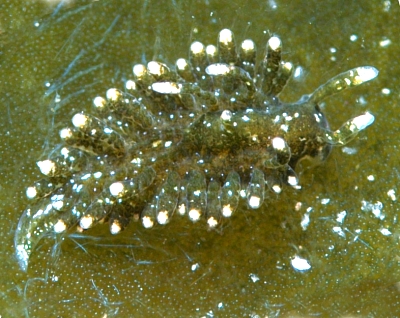
Hi Bill
I was interested to see the recent message [#19156] on Placida dendritica in northern New Zealand.
Coincidentally, I was diving at the Poor Knights Islands (northeastern
NZ) last weekend and observed a number of small slugs which I was unfamiliar with but which appear similar to the Placida dendritica photos on the Forum.
Locality: Poor Knights Islands, 10m, New Zealand, Pacific Ocean, 07 January 2007, Rocky reef. Length: 4mm. Photographer: Ian Skipworth
I saw a fair number of these on two dives. They are probably 3 to 4 mm long and somewhat camouflaged amongst alga so are not easy to see with the naked eye and rather difficult to get a good photo of. From what I saw in the weekend, I suspect they are currently very common at the Poor Knights and think you'd have little difficulty finding them if you know what you're looking for.
Cheers
Ian
ianskip@xtra.co.nz
Skipworth, I.R., 2007 (Jan 10) Placida dendritica in northern NZ. [Message in] Sea Slug Forum. Australian Museum, Sydney. Available from http://www.seaslugforum.net/find/19187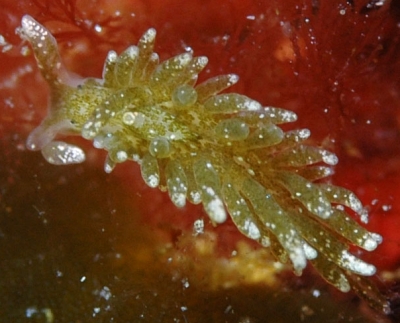
Dear Ian,
Thanks for the rapid response. Looking at your photos makes me wonder whether it is the same as the south-eastern Australian species, but hopefully Cynthia Trowbridge and others working on this complex of species will put us out of our misery soon. Sherman Bleakney (1989) decided Placida dendritica was a worldwide species but more recent work suggests there are a number of distinct regional species. If this proves true then the New Zealand animal, and perhaps its southeastern Australian look-alike, will revert to the old name Placida aoteana (Powell, 1937).
Smaller animals in Sydney look much like your photos, but as they grow they tend to become broader in the body with more flattened cerata.
• Bleakney, J.S. (1989) Morphological variation in the radula of Placida dendritica (Alder & Hancock, 1843) (Opisthobranchia: Ascoglossa/Sacoglossa) from Atlantic and Pacific populations. The Veliger, 32: 171-181.
Best wishes,
Bill Rudman
Placida dendritica in northern New Zealand?
January 9, 2007
From: Ruth Armour
Hello,
I am a graduate student taking a month-long course at the Leigh Marine Lab in Leigh, New Zealand (North Island, near Warkworth). I have been here about 10 days and have not yet found Placida dendritica or Elysia maoria, but was hoping to run some herbivory experiments with these animals (and possibly other ascoglossans). If anyone knows of any specific sites where I can find these, I would appreciate any feedback. I am visiting from the USA so I am not entirely familiar with certain locations, so details on location will also be helpful.
Thank you,
Ruth
gth782n@mail.gatech.edu
Armour, R.A., 2007 (Jan 9) Placida dendritica in northern New Zealand?. [Message in] Sea Slug Forum. Australian Museum, Sydney. Available from http://www.seaslugforum.net/find/19156Dear Ruth,
You have certainly found a beautiful spot to work - and visit. When I was there many years a ago as a student, the lab was much more rudimentary.
Both the sacoglossans you mention feed mainly on an alga we used to know as Codium dichotomum, though I can't be certain that is still it species name. The important thing is that the alga, although usually intertidal, is usually found in crevices or under the brown alga Hormosira banksii [Venus's Necklace] - somewhere damp rather than immersed in a pool. Since its out of water at low tide, the sacoglossans are very difficult to see because they are lying flaccid on the algae. Often the first clue to their presence are their egg masses. The other way is to bring clumps of Codium back to the lab and cover them with sea water and watch for crawling slugs. I can't recall from memory whether the Codium is found on the rock platform at the lab, but it is certainly present in some of the nearby inlets and protected local shores. I am afraid you will need to get advice from local experts on the whereabouts of the Codium, because that is the key to finding the slugs. If you have not yet found this alga, there are some photos on the Fact Sheet and in some of the messages about this species. They are close-ups, but it is the only green algae you will see that looks like a branched finger sponge.
One word of caution however. Although both these slugs are relatively common, I'm afraid sea slugs are hopelessly unreliable. There is no guarantee that even the most common species will be there when you need it.
Good luck with your project,
Best wishes,
Bill Rudman
Placida cf. dendritica from Port Phillip Bay, Victoria
June 22, 2006
From: Trevor McMurrich
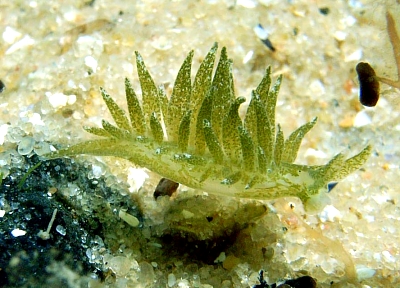
Hi Bill,
This little nudi was floating in the current. I caught it and place it on the sand to get a photo. I was wondering of you could identify it for me?
Locality: Governor Reef, Indented Heads, 3 metres, Victoria, Australia, Port Phillip Bay, 18 June 2006, drifting in the current. Length: 12 mm. Photographer: Trevor McMurrich.
Kind Regards,
Trevor McMurrich
trevm@aanet.com.au
McMurrich, T.B., 2006 (Jun 22) Placida cf. dendritica from Port Phillip Bay, Victoria. [Message in] Sea Slug Forum. Australian Museum, Sydney. Available from http://www.seaslugforum.net/find/16906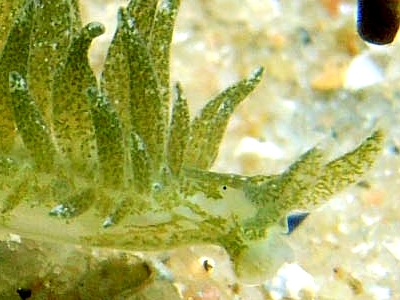
Dear Trevor,
Although this looks quite like an aeolid nudibranch it is in fact a sacoglossan. While both are 'sea slugs', sacoglossans are herbivores while all nudibranchs are carnivores. With few exceptions, sacoglossans feed by piercing the cell wall of particular algae [sea weeds] and sucking out the cell contents. In some species, like this one, the green chloroplasts from the plant are retained alive in the animal's digestive system, where they continue to photosynthesise, providing a plant-like solar powered way of life for the slug. The green specks and network in the body are microscopic branches of the difetive system where the chloroplasts are stored. It is an interesting coincidence that today I am also posting a message on a solar-powered nudibranch [#16890 ] which has a quite different approach to solar-powered life.
At present we can't give you a good name for this species, as there are similar-looking species all around the world which are still being studied to determine just how many species there are. At present we are just calling it Placida cf. dendritica
Best wishes,
Bill Rudman
Placida cf dendritica and eggs
April 11, 2003
From: Rachel Przeslawski
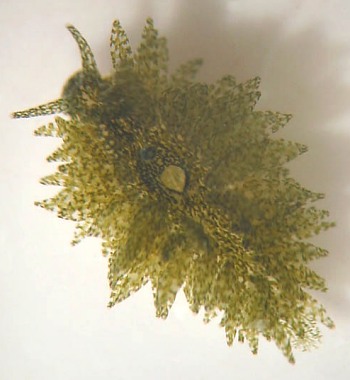
Hi Bill,
Considering the confusion surrounding this species (or group of species), I thought you might want to post these photos of Placida cf dendritica and eggs (spawned in lab). The adults were collected from Wollongong, NSW on Codium. I didn't notice the animals were even there until I got the Codium back to the lab. Their camoflauge is great, but they're all over the Codium here once you look!
Rachel Przeslawski
rachelp@uow.edu.au
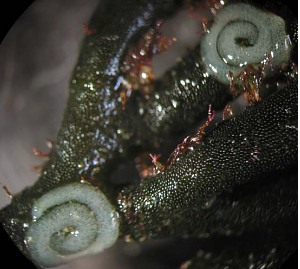
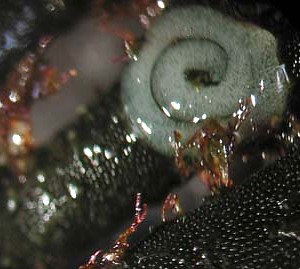
Thanks Rachel,
There seems to be no better camouflage than to colour yourselves with the chloroplasts directly from the algae your sitting and feeding on. This and Elysia maoria, whose egg you illustrated in your last message are the two common feeders on this Codium in New South Wales, so its nice to see the differences in their egg ribbons. This is the ribbon I have always assoiated with Placida cf dendritica so its nice to have it confirmed.
Best wishes,
Bill Rudman
Placida? from Japan
April 27, 2002
From: Nishina Masayoshi

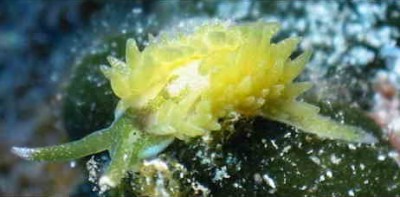
Dear Bill,
I suspect this is a color form of Placida cremoniana but I have never seen one like this.
Photographed by Moguricyo
Data: Hachijyo Island,
Length: 20mm
Best Regards,
Nishina Masayoshi
nishina@wips.co.jp
Masayoshi, N., 2002 (Apr 27) Placida? from Japan. [Message in] Sea Slug Forum. Australian Museum, Sydney. Available from http://www.seaslugforum.net/find/6666Dear Nishina,
This is most probably a species of Placida but not P. cremoniana. I think this is probably the Japanese 'form' of Placida dendritica. It seems to be photographed on Codium, or something similar, but the 'faded' look of the cerata suggest that it may not have fed for a while.
Have a look at Yasuhiro Shirai's message of a specimen from Japan, and Jui-Sheng Chan's from Taiwan.
Hopefully Cynthia Trowbridge or Kathe Jensen will give us an answer.
best wishes,
Bill Rudman
Sacoglossan Placida dendritica
April 14, 2001
From: Shauna Spano
I am looking for information on the Sacoglossan Placida dendritica for a report at school. I'm 13 years old, and have been looking everywhere for infomation on it all over the internet and your site. I haven't been able to find anything more than the article on "Solar Powered Sea Slugs". So perhaps someone could lead me in the right direction.
Thanks!!
Shauna
Stardust_1503@msn.com
Spano, S., 2001 (Apr 14) Sacoglossan Placida dendritica. [Message in] Sea Slug Forum. Australian Museum, Sydney. Available from http://www.seaslugforum.net/find/4158Dear Shauna,
You almost found some information on Placida dendritica. If you click on any word that is underlined it will take you to a page on that topic. Unfortunately I didn't underline Placida dendritica on the Solar Powered Sea Slugs page, but I have now.
So if you go to the Placida dendritica page you will find references to other pages with photos. There are also other messages on P. dendritica below yours on this page, which have more information which will be useful for you. You will see from reading those that there is some debate about whether Placida dendritica is one species found all around the world or a number of different species, each looking quite similar externally, but each restricted to a particular geographic region and probably having differences in anatomy and life history etc.
If you are looking for other information on the Forum try clicking on the buttons at the top of the page, using the SEARCH facility etc.
Good luck with your project,
You haven't been given the simplest 'species' to research.
Best wishes,
Bill Rudman
Re: Placida cf. dendritica from Sydney
March 26, 2000
From: Cynthia Trowbridge
Dear Bill,
Hi. It warms my heart to see all the photos of Placida cf. dendritica. The species is common throughout SE Australia, including Tasmania, around Melbourne (Port Phillip Bay and Western Port), and Sydney. I am using molecular techniques to amplify and sequence mitochondrial genes of this "species" or potential "species complex" throughout the world. I have collected animals from Scotland, Ireland, Australia, New Zealand, Oregon, and Japan to do my molecular work. If any colleagues from South Africa, the Mediterranean, South America, or the east coast of the U.S. had animals, I would gladly pay expenses and a collection fee to include animals from those areas.
In terms of why I think there are more than one species grouped under the name, I have studied the ecology of this "species" pretty intensely since about 1984 and there are some unusual anomalies in the chemical ecology, physiology, behavioural ecology, etc. Such anomalies would be easier to explain if this was a species complex.
Cynthia Trowbridge
trowbric@ucs.orst.edu
Trowbridge, C., 2000 (Mar 26) Re: Placida cf. dendritica from Sydney. [Message in] Sea Slug Forum. Australian Museum, Sydney. Available from http://www.seaslugforum.net/find/2149Dear Cynthia,
If you have photos of any of the other geographic 'forms' I would be happy to post them on the Forum for comparison. If any one can help Cynthia with specimens, it would be great to resolve just what "Placida dendritica" is.
Best wishes,
Bill Rudman.
Placida cf. dendritica & hypodermic insemination
March 26, 2000
From: C. Trowbridge
Dear Bill,
Hi. Just another note about Stephanie's message on "Placida dendritica". You mentioned that in New Zealand this species inseminates partners. The reference for this is under the earlier name Hermaea aoteana Powell on p. 378 in:
• Reid, J.D. (1964) The repoduction of the ascoglossan opisthobranch Elysia maoria. Proc. Zool. Soc. Lond. 143(3): 365-393.
Also, regarding your comments that random injection anywhere on the body has been reported in a couple of species of Elysia but not for stiligerids, I refer you to my paper on the New Zealand Ercolania felina (= Stiliger felinus):
• Trowbridge, C.D. (1995) Hypodermic insemination, oviposition, and embryonic development of a pool-dwelling ascoglossan (=sacoglossan)opisthobranch: Ercolania felina (Hutton, 1882) on New Zealand shores. The Veliger, 38: 203-211.
I recall that Cadet Hand found that Alderia modesta randomly injected conspecifics as well in the following:
• Hand, C. & Steinberg, J. (1955) On the occurrence of the nudibranch Alderia modesta (Loven, 1844) on the central California coast. The Nautilus, 69: 22
Also, in Bleakney's paper uniting Hermaea aoteana, Placida dendritica, etc., I do believe that there may be a SEM of the penial style. Bleakney writes in detail why he considers the species to be a single, world-wide species.
• Bleakney, J.S. (1989) Morphological variation in the radula of Placida dendritica (Alder & Hancock, 1843) (Opisthobranchia: Ascoglossa/Sacoglossa) from Atlantic and Pacific populations. The Veliger, 32: 171-181.
Cordially,
Cynthia
P.S. Keep up the great work!
trowbric@ucs.orst.edu
Trowbridge, C., 2000 (Mar 26) Placida cf. dendritica & hypodermic insemination. [Message in] Sea Slug Forum. Australian Museum, Sydney. Available from http://www.seaslugforum.net/find/2152Dear Cynthia,
Thanks for filling in the details. I remember when I was a student in Auckland, how we use to collect "Hermaea aoteana" & "Stiliger felinus" and watch them 'sneak up' on others of their kind and quickly stab them with their penial stylet. Clearly no thought of political correctness or sexual equality. I think it was not long after someone, (whose name escapes me), had published a paper on one of the species which aims so well at the hidden bursa copulatrix or sperm sac. What I find really amazing is the idea that in some species the injected sperm packet can somehow trigger off the growth of a sperm receptacle to enclose the injected sperm, and then grow a duct to connect the new sperm sac to the reproductive organs.
Best wishes,
Bill Rudman.
Placida cf. dendritica from Sydney
March 23, 2000
From: Stephanie Clark
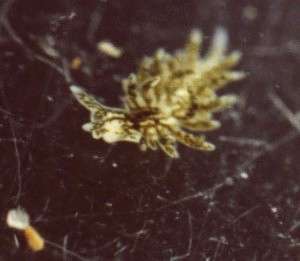
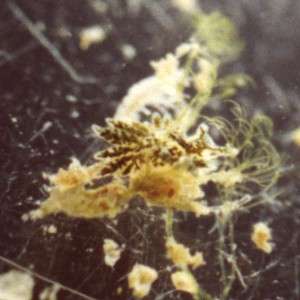
Dear Bill
The small sacoglosans were found on Shark Island, Sydney Harbour, on Codium, on the 26 Oct 1999. The specimens as quite small about 3-4mm. However, I watched the individuals in the photo using a hypodermic needle type copulation method. With one individual basicly stabbing the other any where it likely in mostly in the lower part of the animal around the 'tail' region. From what I could see the needle part of the copulation structure was not barbed in any way but looked just like a small needle.
Regards
Stephanie
inverte@internet-australia.com
Clark, S., 2000 (Mar 23) Placida cf. dendritica from Sydney. [Message in] Sea Slug Forum. Australian Museum, Sydney. Available from http://www.seaslugforum.net/find/1712Dear Stephanie,
Thanks for the observations. I think this is what we are calling Placida dendritica. New Zealand animals of this species have been reported to mate by hypodermic insemination of sperm into their partner but usually near the position of the enclosed sperm sac. Random injection anywhere on the body has been reported in a couple of species of Elysia but not for stiligerids. It is possible that your animals are immature animals just 'practising' or that they are perhaps another species.
Best wishes,
Bill Rudman.
Placida? from Japan
February 16, 2000
From: Yasuhiro Shirai
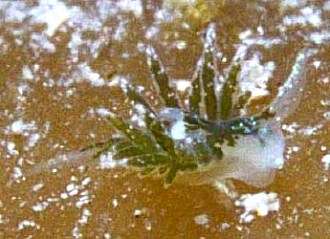
Dear Bill,
Thank you for your quick reply to my last question. I found this opisthobranch at Shima.
This opisthobranch crawled on Colpomenia sinuosa.
Could you please identify this animal for me.
Data:
Location: Shima Pref. Mie Japan (Kii Peninsula east coast)
Length: 2.5mm
Water temperature: 13C
Date Jan. 2000
Depth: 3m
Crawling on seaweed Colpomenia sinuosa.
Best regards,
Yasuhiro Shirai
yasuhiro@e-net.or.jp
Shirai, Y., 2000 (Feb 16) Placida? from Japan. [Message in] Sea Slug Forum. Australian Museum, Sydney. Available from http://www.seaslugforum.net/find/1897Dear Yasuhiro,
When I read that you found this on Colpomenia it made me wonder whether you had a species of Costasiella because I have found one living on Colpomenia. However in that genus the eyes are very close together and that doesn't seem to be the case in your species.
I think your animal is one that is usually called Hermaea dendritica or Placida dendritica. I am afraid there is considerable debate worldwide about whether there is one worldwide species or a number of similar regional species. See Cynthia Trowbridge's message suggesting there are many regional species at present being erroneously identified as Placida dendritica.
Best wishes,
Bill Rudman.
